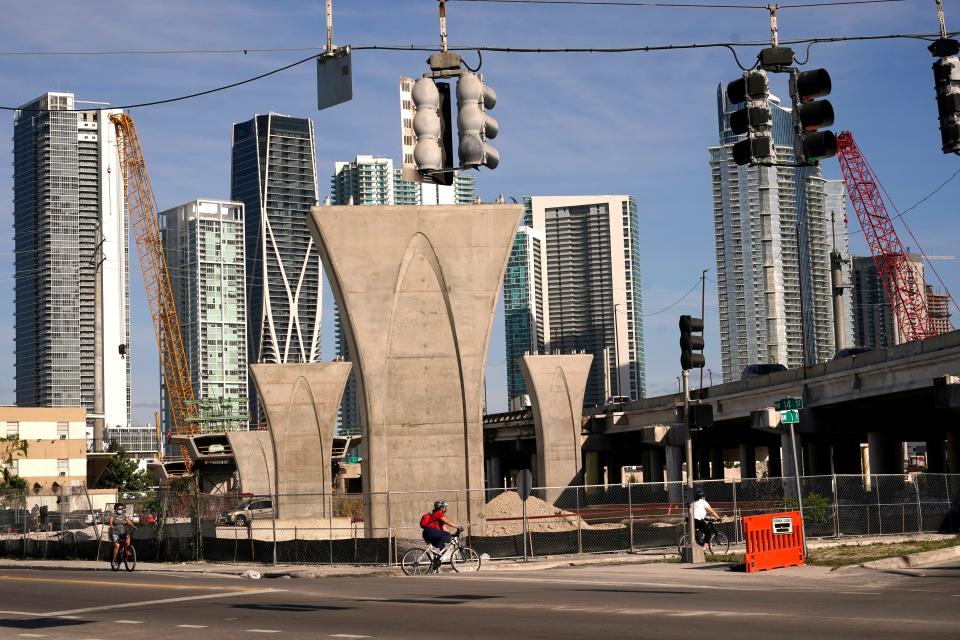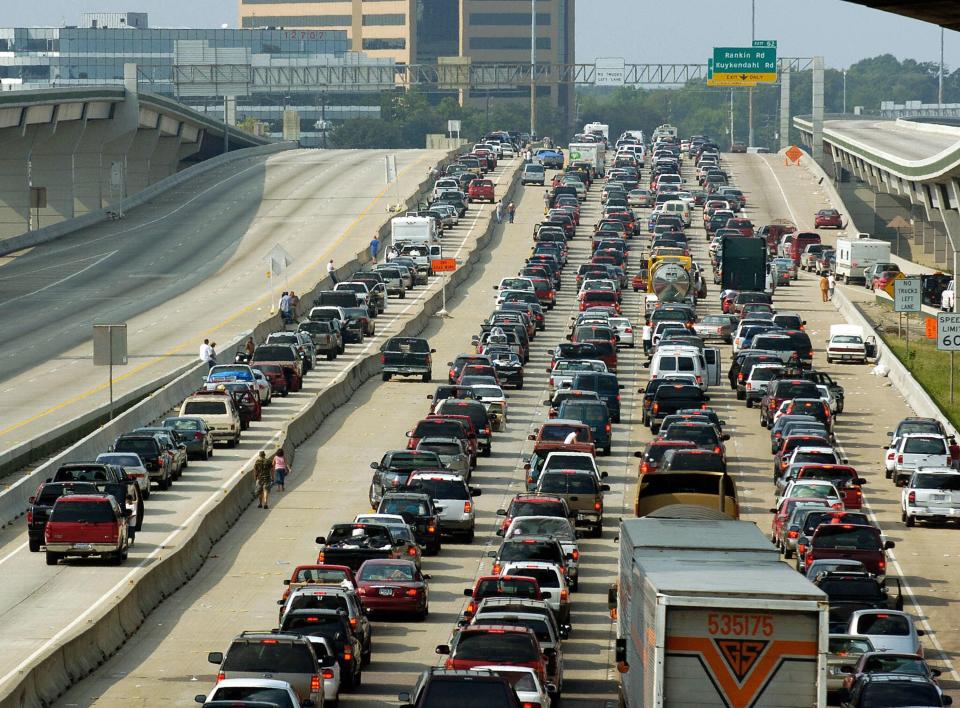What's the price of community? Infrastructure law devotes $1 billion to reconnect neighborhoods split by interstates
Kendra London grew up in the historically Black Fifth Ward neighborhood in Houston, raised by her grandmother and the elders of their community. London thought she would one day become one of them, sitting on the porch and watching over her “village.”
But a multibillion highway project to expand Interstate 45 could displace Black residents in the Fifth Ward – a situation London calls “very painful and legalized theft.”
“It seems to be racial tradition in my community. TxDot (Texas Department of Transportation) did this before,” she said. London’s 83-year-old grandmother, Ella Morris, remembers how construction of I-10 damaged the Fifth Ward during the 1960s.
More than 60 years ago, Black and Latino neighborhoods across the USA were destroyed to make way for the interstate highway system. Businesses were shuttered, places of worship closed and 1 million people were displaced, according to an estimate by former Transportation Secretary Anthony Foxx.
Infrastructure law: 'We're finally getting this done': Biden signs landmark package in major win for domestic agenda
President Joe Biden’s $1.2 trillion Infrastructure Investment and Jobs Act includes $1 billion to reconnect minority neighborhoods.
Experts and advocates told USA TODAY more resources are needed despite the historic investment.
"When you look at the decades of compounded harm in these communities, the physical removal of a highway or the physical transformation of the highway alone simply won't be enough," said New York University law professor Deborah Archer.
The money will be distributed to states through block grants, and communities will lead the way on how to use the money, according to the Biden administration.
“Communities will decide what they want going forward,” Biden senior adviser Cedric Richmond, a former Louisiana congressman, said in November.
“They will be co-architects of their own future. So they will apply for this grant money, and then they'll determine how to best remediate any transportation problems that they have,” he said the day after the infrastructure bill was signed into law.

How highways interrupted communities
"There is racism physically built into some of our highways, and that’s why the jobs plan has specifically committed to reconnect some of the communities that were divided by these dollars,” Transportation Secretary Pete Buttigieg said in an interview with The Grio last year.
Interstate highways expanded during the mid-1950s and 1960s after the Federal-Aid Highway Act of 1956 was signed into law by President Dwight Eisenhower. The 41,000-mile system had devastating consequences. In neighborhoods such as Tremé in New Orleans; Rondo in St. Paul, Minnesota; and Little Mexico in Dallas, vibrant Black and Latino communities were disrupted.
This displacement, scholars noted, occurred around the same time the court system was dismantling segregation in the housing sector and integration of suburban neighborhoods was becoming a reality.
Interstate highway creation furthered racial politics by destroying Black neighborhoods and maintaining segregation "during a time when the traditional tools of racial segregation were being struck down by federal courts," Archer wrote in a Vanderbilt Law Review article.
As the U.S. Department of Transportation works to alleviate these burdens, experts warned that community input, especially the prioritization of people who were wronged, must be at the forefront of the repairs.
Rick Cole, executive director of Congress for the New Urbanism, a nonprofit that collects data on highway removals, told USA TODAY federal, local and state officials cannot host a few meetings if they want to get meaningful engagement and feedback from community members.
The officials, Cole said, “need to go into the local small businesses, the local churches, the local community organizations, even some unlikely sources, like the local schools and local sports clubs and sports groups,” to get feedback from residents on how best to rebuild neighborhoods.

Experts say more money and resources needed to reach racial equity
Experts and advocates told USA TODAY each disrupted community will need its own set of remedies to move forward. For some neighborhoods, there is no realistic solution to reconnect or rebuild what was lost.
“The federal government ultimately cannot craft a one-size-fits-all perfect solution that'll work. So some of this billion dollars will go awry. It's just the nature of a centralized program," Cole said. "But I think it's going to be critically important for people in these communities and their allies to not just rely upon Uncle Sam to make sure that there are equitable outcomes."
Among the options for restoring communities: forming grassroots coalitions, investing in public transit, building walkways and land bridges, or conversely tearing down highways.
Another option "could include redress for families who lost property, who were prevented from the transfer of generational wealth over time through the building of home equity," said Eric Avila, professor of history at UCLA.
Avila cited Santa Monica, California's efforts to provide affordable housing to the descendants of African American and Mexican American families displaced by freeway construction in the 1950s as one model the federal government could replicate.
Collin Yarbrough, author of "Paved A Way: Infrastructure, Policy and Racism in an American City," detailed the destruction of five Black and Latino neighborhoods in Dallas. He said the money earmarked for reconnecting communities is a good first step but less visible social issues are much harder to address.
“It's the loss of community fabric. It's the loss of small business and all of these other incredible neighborhood aspects that used to exist. And money can’t solve those issues,” Yarbrough said. “Money can't fix that trauma that has existed for generations, not only in Dallas but in cities across the country.”
A 'game changer'? Mayors, governors ready to compete for $1 trillion in infrastructure funds

In Texas, community groups fight to block highway expansions from demolishing neighborhoods
Setting aside money to create equity in transportation is an encouraging step, but the displacement of people of color by highway construction is still happening, Yarbrough pointed out.
In Houston, a controversial plan to alleviate traffic woes by widening an interstate highway faced fierce opposition from advocates and Rep. Sheila Jackson Lee, D-Texas, who said it will harm Black and Latino residents by displacing an estimated “1,300 homes, businesses, schools and houses of worship” and increasing noise and air pollution.
Last March, Jackson Lee said her office was working with the Transportation Department to make sure community issues were addressed.
"My belief is that this project should truly be a project that can improve the quality of life of our community not undermine that quality of life!" Jackson Lee tweeted.
The Texas Department of Transportation was given a limited go-ahead from federal authorities to expand sections of I-45. The Federal Highway Administration (FHWA) halted the expansion of I-45 in March to investigate possible violations of Title VI of the 1964 Civil Rights Act. The FHWA wanted to study the effect the project would have on communities of color and low-income families.
Advocacy group Stop TxDOT I-45, along with 15 other local organizations, wrote a letter to Buttigieg at the end of November disputing claims from a letter written by seven Republican members of Congress urging transportation officials to approve the expansion.
“We are writing to urge your continued support of a thorough investigation by the Federal Highway Administration into complaints of civil rights violations by the Texas Department of Transportation (TxDOT),” the groups' letter said. “None of the representatives who authored the November 5, 2021 letter represent districts directly affected by the planned NHHIP (North Houston Highway Improvement Project).”
Fabian Ramirez, a longtime resident of the Near Northside, a Houston neighborhood that would be affected by I-45, calls the widening of I-45 “genocide” on Black and Latino communities. “It's a slap in the face with what they're presenting to us,” said Ramirez, a volunteer for Stop TxDOT I-45, about TxDOT.
“They need to pay attention to what historically has been done to Black and brown neighborhoods across the United States,” he said.
Fellow Stop TxDot I-45 volunteer Alexandra Smither criticized the state DOT for not actively engaging residents.
“They say that they do community engagement, but that community engagement is very restrictive," Smither said. "They’re not actually knocking on people's doors. They're putting out ads online that are really misleading, and they're not targeted towards the people that are actually affected.”
A spokesperson for TxDOT pushed back on allegations the organization didn't adequately engage the community.
"Through more than 300 meetings with the public – including project area residents, stakeholders, business owners, and other interested parties – TxDOT has listened carefully to the needs of the community," chief public information officer Raquelle Lewis said in a statement to USA TODAY.
"In addition to compensating property owners and paying to relocate residents directly impacted, TxDOT will provide more than $27 million in financial assistance for affordable housing in adjacent neighborhoods," Lewis said.
“FHWA’s Office of Civil Rights is making progress in the Title VI investigation of the North Houston Highway Improvement Project and will be prepared to provide specifics once the investigation is completed,” the agency said in a statement to USA TODAY.
A model of racial equity in Minnesota
If Houston is an example of how hard it is for all stakeholders to agree on what equity in infrastructure looks like, the Rondo community in Minnesota is an example of what happens when they come together.
In St. Paul, residents spent decades working to reconnect the Rondo community, a historic Black neighborhood that was devastated by construction of I-94 in the 1950s. The effort involved the ReConnect Rondo advocacy group, the Minnesota Legislature and the state Department of Transportation.
ReConnect Rondo’s mission is to build a land bridge that restores the neighborhood as a cultural enterprise district. The organization, which represents Black descendants of Rondo, has led the way in convening local and state jurisdictions around their vision.
In 2015, Charles Zelle, Minnesota commissioner of transportation, and Chris Coleman, mayor of St. Paul, apologized to Rondo descendants.
“We regret the stain of racism that allowed so callous a decision as the one that led to a family being dragged from their homes,” said Coleman who declared July 17 "Rondo Remembrance and Reconciliation Day.” The group received congressional support from Democratic Rep. Betty McCollum and Sens. Tina Smith and Amy Klobuchar.
In July, the state Legislature approved a $6.2 million package to start the preplanning of the land bridge over I-94. Four months later, St. Paul received an $8 million Rebuilding American Infrastructure with Sustainability and Equity grant from the federal government.
The state funding is the first phase in deciding what will go on top of the bridge, according to Keith Baker, executive director of ReConnect Rondo.
"There are a number of places in which communities will over the next – I would say 12 to 24 months – ultimately get through a process of what I call healing, trust-building, possibility-thinking, ultimately to co-creation," Baker said.
This article originally appeared on USA TODAY: Infrastructure law aims to reconnect Black and Latino neighborhoods

 Yahoo Movies
Yahoo Movies 
